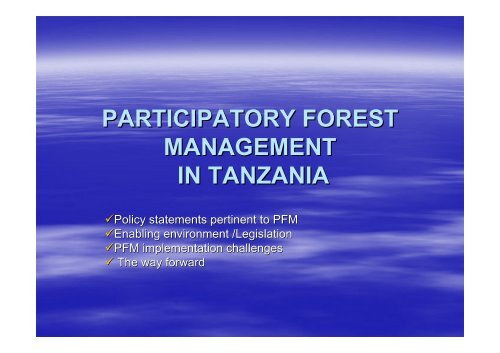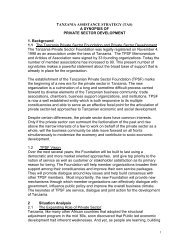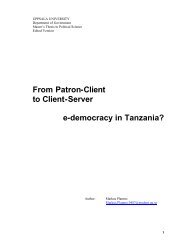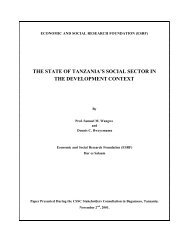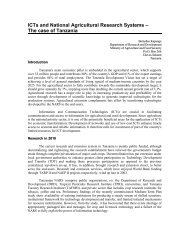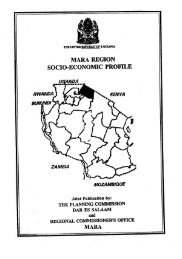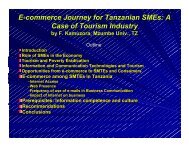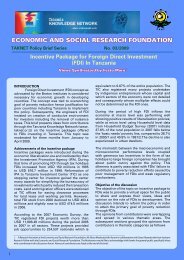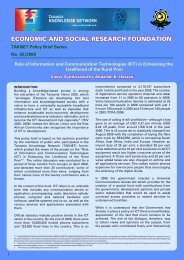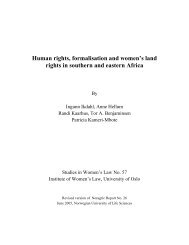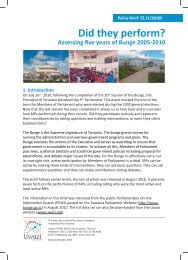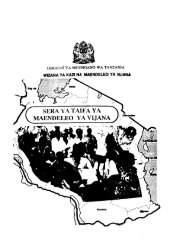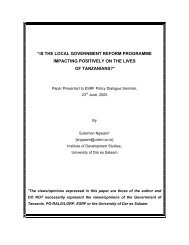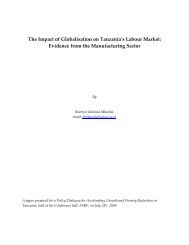participatory forest management in tanzania - Tanzania Online ...
participatory forest management in tanzania - Tanzania Online ...
participatory forest management in tanzania - Tanzania Online ...
You also want an ePaper? Increase the reach of your titles
YUMPU automatically turns print PDFs into web optimized ePapers that Google loves.
PARTICIPATORY FOREST<br />
MANAGEMENT<br />
IN TANZANIA<br />
Policy statements pert<strong>in</strong>ent to PFM<br />
Enabl<strong>in</strong>g environment /Legislation<br />
PFM implementation challenges<br />
The way forward
INTRODUCTION<br />
Participatory Forest Management (PFM) is a strategy to achieve<br />
susta<strong>in</strong>able <strong>forest</strong> <strong>management</strong> by encourag<strong>in</strong>g the <strong>management</strong> or<br />
co-<strong>management</strong> of <strong>forest</strong> and woodland resources by the communities<br />
liv<strong>in</strong>g closest to the resources themselves.<br />
PFM can contribute to improv<strong>in</strong>g rural livelihoods whilst protect<strong>in</strong>g the<br />
environment and promot<strong>in</strong>g gender-equality.
• The vision of the Government of <strong>Tanzania</strong><br />
(GoT)) is to alleviate the widespread poverty<br />
<strong>in</strong> the <strong>Tanzania</strong>n civil society by improv<strong>in</strong>g<br />
socio-economic<br />
opportunities, decentralis<strong>in</strong>g<br />
the functions of government and improv<strong>in</strong>g<br />
the delivery of public services.
POLICIES AND LAWS<br />
SUPPORTING PARTICIPATORY<br />
FOREST MANAGEMENT<br />
• A number of new policies, legislation and<br />
reform programmes have contributed to<br />
the emergence of an enabl<strong>in</strong>g<br />
environment for Participatory Forest<br />
Management and other community-based<br />
natural resource <strong>management</strong> activities <strong>in</strong><br />
<strong>Tanzania</strong>
The Land Policy, Land Act and<br />
Village Land Act<br />
• Land tenure issues are crucial to PFM. The<br />
National Land Policy (1995) set the direction<br />
for land reform and the new land legislation<br />
<strong>in</strong>cludes significant changes to the way land<br />
can be acquired, held and transferred.
• The land reform dist<strong>in</strong>guishes between land<br />
under the authority of central government<br />
and land now under the authority of village<br />
governments. Elected village councils are<br />
now the managers of village communal land<br />
and charged with the supervision and<br />
registration of Village Land with<strong>in</strong> their<br />
respective village spheres, <strong>in</strong>clud<strong>in</strong>g <strong>forest</strong>s<br />
and woodlands.
• Consistent with the National Land Policy (1995), the provisions of<br />
the Land Act (1999) and the Village Land Act (1999) and related<br />
regulations recognize exist<strong>in</strong>g customary rights <strong>in</strong> land and<br />
allows for registration of these rights.<br />
• The Land Acts also acknowledges that customary land rights are<br />
practiced <strong>in</strong> different ways by different ethnic groups all over<br />
<strong>Tanzania</strong> (Village Land Act, 1999, Section 20: 97-98).<br />
98).<br />
• Customary rights as provided for <strong>in</strong> the new laws specifically<br />
<strong>in</strong>clude the right of households, groups, or communities to hold<br />
commons (such as <strong>forest</strong>s) as registered common property.
The Land Policy also specifically<br />
addresses the question of gender,<br />
• "The right of every woman to acquire, hold,<br />
use and deal with land shall to the same<br />
extent and subject to the same restriction be<br />
treated as the right of any man". (The Land<br />
Act, 1999: 26)
The Forest Policy and Forest Act<br />
• The GoT approved the National Forest Policy<br />
<strong>in</strong> 1998. It conta<strong>in</strong>s a number of statements <strong>in</strong><br />
support of PFM.<br />
• The National Forest Policy aims to create an<br />
enabl<strong>in</strong>g environment for the development of<br />
the <strong>forest</strong>ry sector by decentralis<strong>in</strong>g<br />
responsibilities for <strong>forest</strong> <strong>management</strong> to local<br />
communities and district councils
POLICY STATMENTS<br />
• PS 3: To enable participation of all<br />
stakeholders <strong>in</strong> <strong>forest</strong> <strong>management</strong> and<br />
conservation, jo<strong>in</strong>t <strong>management</strong> agreements, with<br />
appropriate user rights and benefits, will be<br />
established. The agreement will be between the<br />
central government, specialised executive<br />
agencies, private sector or local governments as<br />
appropriate <strong>in</strong> each case and organised local<br />
communities or other organisations of people<br />
liv<strong>in</strong>g adjacent to the <strong>forest</strong>.
• PS 5:<br />
To enable susta<strong>in</strong>able <strong>management</strong><br />
of <strong>forest</strong>s on public lands, clear ownership<br />
for all <strong>forest</strong>s and trees on those lands will<br />
be def<strong>in</strong>ed. The allocation of <strong>forest</strong>s and<br />
their <strong>management</strong> responsibility to villages,<br />
private <strong>in</strong>dividuals or to the government will<br />
be promoted. Central, local and village<br />
governments may demarcate and establish<br />
new <strong>forest</strong> reserves.
• PS 6: Village <strong>forest</strong> reserves will be<br />
managed by the village governments or<br />
other entities designated by village<br />
governments for this purpose. They will be<br />
managed for production and/or protection<br />
based on susta<strong>in</strong>able <strong>management</strong><br />
objectives def<strong>in</strong>ed for each <strong>forest</strong> reserve.<br />
The <strong>management</strong> will be based on <strong>forest</strong><br />
<strong>management</strong> plans.
• PS 7: Private and community <strong>forest</strong>ry<br />
activities will be supported through<br />
harmonised extension service and f<strong>in</strong>ancial<br />
<strong>in</strong>centives. The extension package and<br />
<strong>in</strong>centives will be designed <strong>in</strong> a gender<br />
sensitive manner. Extension services and<br />
f<strong>in</strong>ancial <strong>in</strong>centives will be provided <strong>in</strong><br />
support of “<strong>forest</strong>ry activities” per se.
FOREST LEGISLATION<br />
• The Forest Act (No. 7, June 2002) provides<br />
the legal framework to implement the<br />
National Forest Policy.
• The Forest Act supports PFM by enabl<strong>in</strong>g<br />
local communities to declare – and<br />
ultimately gazette – Village, Group or<br />
Private Forest Reserves
The Act provides for three<br />
categories of community-based<br />
Forest Management (CBFM):<br />
• Village Land Forest Reserves (VLFR)<br />
managed by the entire community,<br />
• Community Forest Reserves (CFR)<br />
managed by a particular designated group<br />
<strong>in</strong> the community, and<br />
• Private Forests (PF) managed by <strong>in</strong>dividual<br />
designated households.
• The Forest Act also provides for registration<br />
and other procedures through which<br />
villages, groups or <strong>in</strong>dividuals may secure<br />
local jurisdiction over <strong>forest</strong>s or take on<br />
<strong>management</strong> functions <strong>in</strong> Central and Local<br />
Government Forest Reserves through the<br />
establishment of Jo<strong>in</strong>t Forest Management<br />
(JFM) Agreements with the appropriate<br />
government authority.
Objectives of the Forest Act<br />
• encourage and facilitate the active citizen <strong>in</strong>volvement<br />
<strong>in</strong> the susta<strong>in</strong>able plann<strong>in</strong>g, <strong>management</strong>, use and<br />
conservation of <strong>forest</strong> resources through the<br />
development of <strong>in</strong>dividual and community rights;<br />
• ensure ecosystem stability through conservation of<br />
<strong>forest</strong> biodiversity, water catchments and soil fertility;<br />
• delegate responsibility for the <strong>management</strong> of <strong>forest</strong><br />
resources to the lowest possible level of local<br />
<strong>management</strong> consistent with national policies;<br />
• ensure the susta<strong>in</strong>able supply of <strong>forest</strong> products and<br />
services by ma<strong>in</strong>ta<strong>in</strong><strong>in</strong>g sufficient <strong>forest</strong> area under<br />
efficient, effective and economical <strong>management</strong>;
• enhance the quality and improve the marketability of<br />
<strong>forest</strong> products and regulate their export;<br />
• promote coord<strong>in</strong>ation and cooperation between the<br />
<strong>forest</strong> sector and other agencies and bodies <strong>in</strong> the<br />
public and private sectors;<br />
• facilitate greater public awareness of the cultural,<br />
economic and social benefits of conserv<strong>in</strong>g and<br />
<strong>in</strong>creas<strong>in</strong>g susta<strong>in</strong>able <strong>forest</strong> cover by develop<strong>in</strong>g<br />
programs <strong>in</strong> tra<strong>in</strong><strong>in</strong>g, research and public education;<br />
and<br />
• enable <strong>Tanzania</strong> to play a full part <strong>in</strong> contribut<strong>in</strong>g<br />
towards and benefit<strong>in</strong>g from <strong>in</strong>ternational efforts and<br />
measures to protect and enhance global biodiversity.
Gender Concern under the Forest<br />
Policy 0f 1998<br />
• “Private and community <strong>forest</strong>ry activities will be<br />
separated through harmonized extension services<br />
and f<strong>in</strong>ancial <strong>in</strong>centives. The extension package<br />
and <strong>in</strong>centives will be designed <strong>in</strong> a gender<br />
sensitive manner” (PS 7) and<br />
• “Local communities will be encouraged to<br />
participate <strong>in</strong> <strong>forest</strong> activities. Clearly def<strong>in</strong>ed<br />
<strong>forest</strong> land and tree tenure rights will be <strong>in</strong>stituted<br />
for local communities <strong>in</strong>clud<strong>in</strong>g both men and<br />
women.” (PS 39)
Related policy and legislative<br />
frameworks<br />
CROSS SECTORAL AREAS<br />
• In addition to the Forest, Land and Village Land Acts,<br />
the implementation of PFM activities is also <strong>in</strong>fluenced<br />
by other related policy and legislative frameworks.<br />
These <strong>in</strong>clude i.a. . the National Wildlife Policy and<br />
Wildlife Management Area Regulations, the new<br />
Beekeep<strong>in</strong>g Act, the Public Procurement Act (No. 3,<br />
2001) and relevant legislation from the agricultural<br />
sector.<br />
• Furthermore, the draft<strong>in</strong>g of an environmental<br />
<strong>management</strong> bill (ILFEMP) provide a crucial <strong>in</strong>strument<br />
to ensure vertical and horizontal <strong>in</strong>tegration of <strong>forest</strong>ry<br />
activities <strong>in</strong>to overall framework for environmental<br />
<strong>management</strong> <strong>in</strong> <strong>Tanzania</strong>.
PARTICIPATORY FOREST<br />
MANAGEMENT IN TANZANIA<br />
• PFM is a strategy to achieve susta<strong>in</strong>able <strong>forest</strong> <strong>management</strong> by<br />
promot<strong>in</strong>g the <strong>management</strong> or co-<strong>management</strong> of <strong>forest</strong> and woodland<br />
resources by the communities liv<strong>in</strong>g closest to the resources.<br />
• It is characterised by the <strong>forest</strong>-local communities “shar<strong>in</strong>g power”<br />
(devolution) <strong>in</strong>stead of just benefits, and assum<strong>in</strong>g owner/user rights r<br />
and<br />
<strong>management</strong> of the <strong>forest</strong> resources.<br />
•<br />
The term PFM is synonymous with the generic term Community-based<br />
Forest Management (CBFM)<br />
• However, ‘CBFM’ is used to denote community <strong>management</strong> of still<br />
unreserved <strong>forest</strong>s <strong>in</strong> Village or General Lands while the term ‘Jo<strong>in</strong>t<br />
Forest Management (JFM)’ is used to denote co-<strong>management</strong> regimes <strong>in</strong><br />
respect of government <strong>forest</strong> reserves (National Forest Reserves and/or<br />
Local Authority Forest Reserves).
• There is no exact def<strong>in</strong>ition of PFM but it is<br />
conceptually part of an overall rural<br />
development strategy which aims to improve<br />
rural livelihoods and thereby help to reduce<br />
poverty whilst at the same time protect<strong>in</strong>g<br />
the environment and promot<strong>in</strong>g gender-<br />
equality and democracy.
The Statutory Basis for Participatory Forest<br />
Management<br />
• Community-based <strong>management</strong> of <strong>forest</strong> resources is founded on the authority<br />
of village governments to set aside areas for <strong>forest</strong>ry with<strong>in</strong> their village land.<br />
• The legal status of the <strong>management</strong> plan vis à vis exclusion of external<br />
<strong>in</strong>terests <strong>in</strong> the <strong>forest</strong> as well as <strong>in</strong>ternal compliance with <strong>management</strong> rules<br />
and regulations can be enhanced through pass<strong>in</strong>g a related Village e by-law and<br />
the <strong>forest</strong> may eventually be gazetted as a Village Land Forest Reserve R<br />
(VLFR).<br />
• Subject to approval by the Village Council, smaller groups <strong>in</strong>clud<strong>in</strong>g sub-<br />
villages, women groups, ethnic groups, etc. may manage <strong>forest</strong> resources on<br />
village lands, be<strong>in</strong>g part of or separate from village land <strong>forest</strong>s, as Community<br />
Forests.<br />
• On request, or if considered to be <strong>in</strong> the public <strong>in</strong>terest, the Director D<br />
of <strong>forest</strong>ry<br />
may assist such groups <strong>in</strong> form<strong>in</strong>g themselves with the purpose of apply<strong>in</strong>g to<br />
manage a <strong>forest</strong> as a community <strong>forest</strong> reserve (Forest Act 2002, s. 42-45). 45). Two<br />
or more villages may decide to jo<strong>in</strong>tly manage a <strong>forest</strong> resource that covers<br />
parts of their respective territory (Forest Act 2002, s. 38).
• Jo<strong>in</strong>t <strong>forest</strong> <strong>management</strong> is based on the<br />
authority of the National and Local Governments<br />
to share <strong>management</strong> rights and responsibilities<br />
over their <strong>forest</strong> reserves and plantations with<br />
<strong>forest</strong> adjacent communities. The division of<br />
rights and responsibilities, <strong>in</strong>clud<strong>in</strong>g shar<strong>in</strong>g of<br />
costs and benefits, is subject to negotiations <strong>in</strong><br />
each specific case and detailed <strong>in</strong> a written jo<strong>in</strong>t<br />
<strong>forest</strong> <strong>management</strong> agreement (Forest Act 2002,<br />
s.16). Accord<strong>in</strong>gly, JFM represents a contractual<br />
relationship between the relevant government<br />
<strong>in</strong>stitutions and local communities.
Objectives of Participatory Forest<br />
Management<br />
• PFM has a dual objective of improv<strong>in</strong>g rural<br />
livelihoods and <strong>forest</strong> conservation through<br />
a strategy of power shar<strong>in</strong>g between local<br />
communities and statutory agencies vis á<br />
vis the <strong>management</strong> of <strong>forest</strong> resources.<br />
Backed by the legal framework provided by<br />
the Forest Act (2002)
PFM aims to address the follow<strong>in</strong>g two ma<strong>in</strong> “problems”<br />
as identified <strong>in</strong> the Forest Policy (1998, s. 4.1.1 and s.<br />
4.4.11):<br />
• 1. The low capacity of government <strong>in</strong>stitutions to manage<br />
central and local government <strong>forest</strong> reserves to meet the grow<strong>in</strong>g<br />
demands for <strong>forest</strong> products and services, which has resulted <strong>in</strong><br />
destruction, degradation and conversion to other unsusta<strong>in</strong>able<br />
land uses of these <strong>forest</strong> resources<br />
• 2. Conversion of unreserved <strong>forest</strong>s on communal and public<br />
lands (mostly on village lands) to other land uses due to<br />
previously unclear land and tree tenure, particularly for<br />
<strong>in</strong>digenous trees. This has underm<strong>in</strong>ed economic <strong>in</strong>centives for<br />
susta<strong>in</strong>able <strong>forest</strong> <strong>management</strong> by local communities and, hence,<br />
resulted <strong>in</strong> poor motivation to plant and care for <strong>forest</strong>s and trees.
• Socially, economically and environmentally<br />
sound <strong>forest</strong> <strong>management</strong> plans are<br />
considered the ma<strong>in</strong> vehicle to secure<br />
susta<strong>in</strong>able protection and utilisation of<br />
<strong>forest</strong> resources. With the exception of<br />
private <strong>forest</strong>s smaller than 50 ha,<br />
<strong>management</strong> plans are compulsory for all<br />
<strong>forest</strong> types irrespective of <strong>management</strong><br />
arrangements (Forest Act, 2002, s. 11-16).<br />
16).
• Like <strong>in</strong> most other countries where PFM is<br />
practised, it is aga<strong>in</strong>st this trade off that the<br />
national and local governments share authority<br />
over <strong>forest</strong> resources with local communities.<br />
Accord<strong>in</strong>gly, the Director of <strong>forest</strong>ry or local<br />
governments may for a specified period take over<br />
the <strong>management</strong> of <strong>forest</strong>s that are under JFM or<br />
CBFM, if these are deemed to be mismanaged<br />
(Forest Act 2002, s. 8 and 41-48).<br />
48).
Experiences with Participatory<br />
Forest Management <strong>in</strong> <strong>Tanzania</strong><br />
• Over the past two decades ‘community<br />
<strong>forest</strong>ry’<br />
and ‘<strong>participatory</strong> <strong>forest</strong><br />
<strong>management</strong>’ activities have been tried and<br />
tested <strong>in</strong> different parts of <strong>Tanzania</strong>. These<br />
activities have been almost exclusively<br />
donor-supported projects <strong>in</strong> discrete areas<br />
and to date, little effort has been made to<br />
co-ord<strong>in</strong>ate ord<strong>in</strong>ate and summarise lessons learned.
The follow<strong>in</strong>g observations constitute some provisional<br />
generic lessons learned from approaches to PFM.<br />
• The local and central government <strong>in</strong>stitutions do<br />
not presently have the capacity, f<strong>in</strong>ancial means or<br />
implementation mechanisms to adequately<br />
support PFM at a larger scale. Particularly at<br />
district and village level, decentralisation without<br />
devolution of power to manage <strong>forest</strong> resources is<br />
a risk unless revenues can be <strong>in</strong>creased and/or<br />
external funds can be mobilised.
• In many cases, the most important effect of PFM<br />
has, this far, not been improved <strong>forest</strong><br />
<strong>management</strong> per se, but rather community<br />
empowerment dur<strong>in</strong>g the process of acquir<strong>in</strong>g<br />
legal authority over land designated for <strong>forest</strong>ry.<br />
• External support is generally needed to realise the<br />
opportunities of PFM <strong>in</strong> promot<strong>in</strong>g community<br />
empowerment and rural development, as the<br />
number of professionals with adequate skills to<br />
facilitate the process <strong>in</strong> the field is low.
• The official establishment of village boundaries<br />
may play a crucial role <strong>in</strong> prevent<strong>in</strong>g and<br />
manag<strong>in</strong>g conflicts over village land and village<br />
land <strong>forest</strong>s.<br />
• At village and district level, PFM should form part<br />
of an overall land-use plann<strong>in</strong>g to prevent conflicts<br />
over land and to ensure that each sector can<br />
contribute to improve rural livelihoods.
• Limited knowledge at village level about their<br />
“new” legal rights and responsibilities hampers<br />
land-use plann<strong>in</strong>g, which results <strong>in</strong> opportunities<br />
foregone and conflicts.<br />
• The Community-Based Forest Management<br />
Guidel<strong>in</strong>es (2001) form a good basis for facilitat<strong>in</strong>g<br />
PFM, but more detailed guidel<strong>in</strong>es are needed on<br />
develop<strong>in</strong>g concrete <strong>participatory</strong> <strong>forest</strong><br />
<strong>management</strong> plans and <strong>forest</strong> <strong>management</strong><br />
related by-laws.
• Local communities require long-term external support to<br />
facilitate PFM, e.g. the preparation of CBFM and JFM<br />
<strong>management</strong> plans has <strong>in</strong> many cases taken years to<br />
accomplish.<br />
• The economic net benefits of PFM to local communities<br />
are often limited, especially <strong>in</strong> the <strong>in</strong>itial stage and<br />
especially under JFM, but the net benefits to the state and<br />
society <strong>in</strong> terms of reduced <strong>management</strong> costs, <strong>in</strong>creased<br />
effectiveness of <strong>forest</strong> protection and secur<strong>in</strong>g<br />
environmental services are often substantial and<br />
immediate.
• Rules and arrangements for cost and benefit<br />
shar<strong>in</strong>g between government <strong>in</strong>stitutions and local<br />
communities must result <strong>in</strong> tangible and concrete<br />
benefits to local communities, if community<br />
participation is to be susta<strong>in</strong>ed.<br />
• Rural households often derive more than 50% of<br />
their cash <strong>in</strong>come from <strong>forest</strong> resources, with<br />
honey, beeswax, charcoal and pit sawn timber<br />
be<strong>in</strong>g the most important products.
• PFM activities based on traditional<br />
<strong>management</strong> systems enhance the<br />
likelihood of success.<br />
• Communities’ demand for PFM is strongest<br />
where the <strong>forest</strong> resource has been<br />
depleted and/or where external <strong>in</strong>terests are<br />
already exploit<strong>in</strong>g or attempt<strong>in</strong>g to exploit it.
• Time and effort is required to ensure accountability<br />
and transparency of the PFM process at village<br />
level. Village government structures must be<br />
closely <strong>in</strong>volved and the whole village population<br />
kept <strong>in</strong>formed.<br />
• In most areas, communities do not rank PFM<br />
among their top priorities, like health and<br />
education. This has resulted <strong>in</strong> PFM activities<br />
often be<strong>in</strong>g supply/donor driven.
Participatory Forest Management<br />
<strong>in</strong> the National Forestry<br />
Programme<br />
• In November 2001 the GoT approved a<br />
National Forest Programme (NFP) as the<br />
key <strong>in</strong>strument for implementation of the<br />
National Forest Policy.
• The NFP provides the framework for <strong>forest</strong> sector<br />
plann<strong>in</strong>g dur<strong>in</strong>g the period 2001 – 2010, and has<br />
four ma<strong>in</strong> programme areas<br />
a) Forest Resources Conservation and<br />
Management,<br />
b) Institutions and Human Resources Development<br />
c) Legal and Regulatory Framework, and<br />
d) Forestry Based Industries and Susta<strong>in</strong>able<br />
Livelihoods.
• All four programmes are relevant to PFM<br />
although the Forest Resources<br />
Conservation and Management Programme<br />
specifically aims to promote gender<br />
balanced stakeholders’ participation <strong>in</strong> the<br />
<strong>management</strong> of natural <strong>forest</strong>s, woodlands<br />
and plantations.
The NFP outl<strong>in</strong>es the general<br />
pr<strong>in</strong>ciples for PFM.<br />
PFM activities should build on exist<strong>in</strong>g<br />
experiences and follow a number of key<br />
guid<strong>in</strong>g pr<strong>in</strong>ciples cited <strong>in</strong> the NFP <strong>in</strong>clud<strong>in</strong>g<br />
i.a.
• Susta<strong>in</strong>able <strong>management</strong> of <strong>forest</strong>s on Village<br />
Lands should focus on the development of clear<br />
rights of ownership, access and use for all <strong>forest</strong>s<br />
and trees on those lands.<br />
• Devolv<strong>in</strong>g <strong>management</strong> to specialized executive<br />
agencies, rural communities and the private sector<br />
should be based on the use of simple, low-cost<br />
and replicable <strong>forest</strong> <strong>management</strong> plans.
• Increased attention should be given to poverty<br />
reduction and gender-related related issues related to the<br />
<strong>in</strong>come generation opportunities from timber,<br />
fuelwood and non-wood <strong>forest</strong> products.<br />
• Demarcation of protective buffer zones around<br />
gazetted <strong>forest</strong> reserves with biodiversity and<br />
other amenity values should provide tangible<br />
benefits for local communities.<br />
• Inter-sectoral<br />
co-ord<strong>in</strong>ation ord<strong>in</strong>ation and stakeholder<br />
consultation should be strengthened.
<strong>Tanzania</strong> Forest Conservation and<br />
Management Project<br />
• TFCMP is assist<strong>in</strong>g the GoT<br />
to design and<br />
establish the <strong>Tanzania</strong> Forest Service (TFS) as a<br />
specialised 'executive agency' <strong>in</strong> accordance with<br />
the Executive Agencies Act (1997). It is envisaged<br />
that the TFS will, among other th<strong>in</strong>gs, have<br />
responsibility for br<strong>in</strong>g<strong>in</strong>g about improvements <strong>in</strong><br />
the protection and <strong>management</strong> of natural <strong>forest</strong>s<br />
and the development and <strong>management</strong> of<br />
<strong>in</strong>dustrial plantations. The TFS will be the future<br />
focal po<strong>in</strong>t for PFM activities <strong>in</strong> <strong>Tanzania</strong>.
Opportunities for geographical<br />
expansion<br />
• The implementation of PFM activities <strong>in</strong> <strong>Tanzania</strong> has covered<br />
less than 1% of the total <strong>forest</strong> and woodland areas <strong>in</strong> the country.<br />
• In addition, PFM activities are scattered and regionally<br />
concentrated. For example, out of 594 Village Forest Reserves,<br />
432 were <strong>in</strong> Mwanza Region alone.<br />
• There is a generic lack of <strong>in</strong>terest <strong>in</strong> Jo<strong>in</strong>t Forest Management<br />
(JFM) activities due to the limited benefits to be ga<strong>in</strong>ed, especially<br />
<strong>in</strong> relation to the conservation of catchment <strong>forest</strong>s.<br />
• The promotion and implementation of PFM should focus on<br />
economic and social <strong>in</strong>centive structures for the communities.
• There are more than 600 government <strong>forest</strong><br />
reserves <strong>in</strong> <strong>Tanzania</strong> cover<strong>in</strong>g approximately 14<br />
million ha or 13% of the total land area. In<br />
pr<strong>in</strong>ciple, JFM is an option for all these <strong>forest</strong>s, but<br />
due to remoteness there will be <strong>forest</strong>s with no<br />
obvious local communities to participate <strong>in</strong> JFM<br />
and <strong>in</strong> places where <strong>forest</strong> resources are still<br />
abundant, local communities’ motivation for PFM<br />
will be too low.
Opportunities for coord<strong>in</strong>ated<br />
support<br />
Dist<strong>in</strong>ct opportunities exist to strengthen support<br />
for PFM activities <strong>in</strong> <strong>Tanzania</strong>, such as;<br />
• The (eventual) establishment of a basket fund to<br />
f<strong>in</strong>ance the <strong>forest</strong> sector is envisaged <strong>in</strong> the<br />
National Forest Programme (NFP). A basket fund<br />
would enable donors to contribute to a more co-<br />
ord<strong>in</strong>ated support to PFM, thereby mak<strong>in</strong>g national<br />
PFM coverage feasible.
• Danida support to the PFM Component forms part<br />
of the larger <strong>Tanzania</strong> Forest Conservation and<br />
Management Project (TFCMP) – itself be<strong>in</strong>g<br />
implemented as an important part of the National<br />
Forest Programme. L<strong>in</strong>kages to both TFCMP and<br />
NFP will provide opportunities for synergy,<br />
improved co-ord<strong>in</strong>ation ord<strong>in</strong>ation of activities, jo<strong>in</strong>t reviews,<br />
exchange of experience and lessons learned and<br />
the anticipated benefits of <strong>in</strong>stitutional and fiscal<br />
reform processes <strong>in</strong> the sector.
• The planned l<strong>in</strong>kages with the Agricultural<br />
Sector Support Programme (ASPS) <strong>in</strong><br />
certa<strong>in</strong> regions/districts will also provide<br />
opportunities for synergy, for example, <strong>in</strong><br />
terms of develop<strong>in</strong>g multidiscipl<strong>in</strong>ary<br />
extension services, capacity build<strong>in</strong>g and<br />
f<strong>in</strong>ancial <strong>management</strong>.
Generic obstacles<br />
• PFM is a development strategy that is be<strong>in</strong>g empirically tested <strong>in</strong> i<br />
<strong>Tanzania</strong> and many other countries <strong>in</strong> Africa. The approach<br />
centres on the reconstitution of <strong>in</strong>centives at the local level. It<br />
ensures that the people who are closest to the resource are given<br />
a greater stake <strong>in</strong> its long-run viability and are directly <strong>in</strong>volved <strong>in</strong><br />
the effective use, <strong>management</strong> and protection of the resources.<br />
• No studies have yet clearly demonstrated a correlation between<br />
PFM and improvements <strong>in</strong> rural <strong>in</strong>come and livelihoods.<br />
• However, there are many <strong>in</strong>dications that such correlations may<br />
exist and also that PFM has a positive impact on local democracy<br />
and participation and that it, through devolution, transfers control<br />
of decision-mak<strong>in</strong>g to local communities
• The ”promise” of PFM rests on the assumption<br />
that if the ”right” <strong>in</strong>centives are established at<br />
grass root level, then local people will take active<br />
part <strong>in</strong> (or take full responsibility for) the protection<br />
and <strong>management</strong> of local <strong>forest</strong> resources. This<br />
should counteract <strong>forest</strong> loss at the national level<br />
and contribute to susta<strong>in</strong>able socio-economic<br />
development at the local level, i.e. serve the dual<br />
objective of <strong>forest</strong> protection and rural<br />
development.
SPECIFIC LIMITS TO AND<br />
CHALLENGES OF EXPANDING<br />
PFM IN TANZANIA
• The limited knowledge at all levels about legal<br />
aspects of PFM. This poses a bottleneck to local<br />
demand for and official supply of PFM services. It<br />
also constitutes a risk of “elite capture” at village<br />
level whereby vulnerable sub-groups (the poor,<br />
the landless, women, ethnic m<strong>in</strong>orities, etc.) could<br />
be further marg<strong>in</strong>alised.<br />
• The limited land-use plann<strong>in</strong>g capacity <strong>in</strong> many<br />
districts and villages. This might result <strong>in</strong> confusion<br />
and conflict over which areas should and should<br />
not be set aside for <strong>forest</strong>ry.
Opportunities for promot<strong>in</strong>g a more<br />
gender-balanced approach to PFM<br />
<strong>in</strong>clude:<br />
• Empowerment of women <strong>in</strong> <strong>management</strong>.<br />
This can take place through women groups’<br />
<strong>in</strong>volvement <strong>in</strong> decision mak<strong>in</strong>g and access<br />
to resources;<br />
• Gender sensitive tra<strong>in</strong><strong>in</strong>g, which recognises<br />
the specific needs of both men and women<br />
<strong>in</strong> terms of tim<strong>in</strong>g, form and venue;
Democratisation and conflict<br />
resolution<br />
• PFM is <strong>in</strong> pr<strong>in</strong>ciple a democratisation of the <strong>forest</strong> <strong>management</strong><br />
regime. Usually committees responsible for PFM <strong>in</strong> the Villages<br />
are elected by the Village Assembly, and therefore (<strong>in</strong> theory, at a<br />
least) directly accountable to the electorate rather than to the<br />
elected Village Council. However, some user groups such as the<br />
agro-pastoralists/pastoralists are often marg<strong>in</strong>alized and do not<br />
participate fully <strong>in</strong> the democratic processes <strong>in</strong> the society.<br />
• Therefore, whilst PFM should ideally help solve conflicts it may<br />
also create or aggravate conflicts. It is of great importance that<br />
PFM <strong>in</strong>clude and consider modalities for resolv<strong>in</strong>g such conflicts<br />
over resources. Conflicts occur with<strong>in</strong> and between villages, and<br />
between groups with<strong>in</strong> a village over access to and use of<br />
resources, as well as between villages and districts, e.g. on<br />
distribution of revenue from <strong>forest</strong> reserves.
INSTRUMENTS TO SUPPORT<br />
PARTICIPATORY FOREST<br />
MANAGEMENT<br />
• The National Forest Policy of March 1998<br />
provides the policy framework for the<br />
delegation of many <strong>forest</strong> <strong>management</strong> and<br />
conservation tasks to local government<br />
authorities, NGOs, CBOs<br />
and resource<br />
users at the community level
• The GoT<br />
subsequently developed and<br />
approved the National Forest Programme <strong>in</strong><br />
2001 as the strategic plann<strong>in</strong>g <strong>in</strong>strument to<br />
implement the policy, to enhance<br />
susta<strong>in</strong>able <strong>forest</strong> <strong>management</strong> and to<br />
improve the design, implementation and<br />
coord<strong>in</strong>ation of projects and programmes<br />
with<strong>in</strong> the <strong>forest</strong>ry sector.
• The Forest Act (No. 7, 2002) complements<br />
earlier legislation <strong>in</strong> provid<strong>in</strong>g an enabl<strong>in</strong>g<br />
environment to facilitate the devolved and<br />
collaborative <strong>management</strong> of <strong>forest</strong> and<br />
woodland resources <strong>in</strong> <strong>Tanzania</strong>. Additional<br />
reforms are envisaged for <strong>forest</strong>ry and other<br />
sectors which may <strong>in</strong>fluence the<br />
<strong>management</strong> of <strong>forest</strong>s and woodlands.
THE WAY FORWARD<br />
• <strong>Tanzania</strong> is develop<strong>in</strong>g a number of guidel<strong>in</strong>es for<br />
‣ Facilitat<strong>in</strong>g Participatory Forest Management<br />
‣ Assess<strong>in</strong>g Participatory Forest Management<br />
‣ Monitor<strong>in</strong>g & Evaluat<strong>in</strong>g PFM Contribution to<br />
poverty alleviation <strong>in</strong> the context of Poverty<br />
Reduction Strategies (PRSP)
THE END


